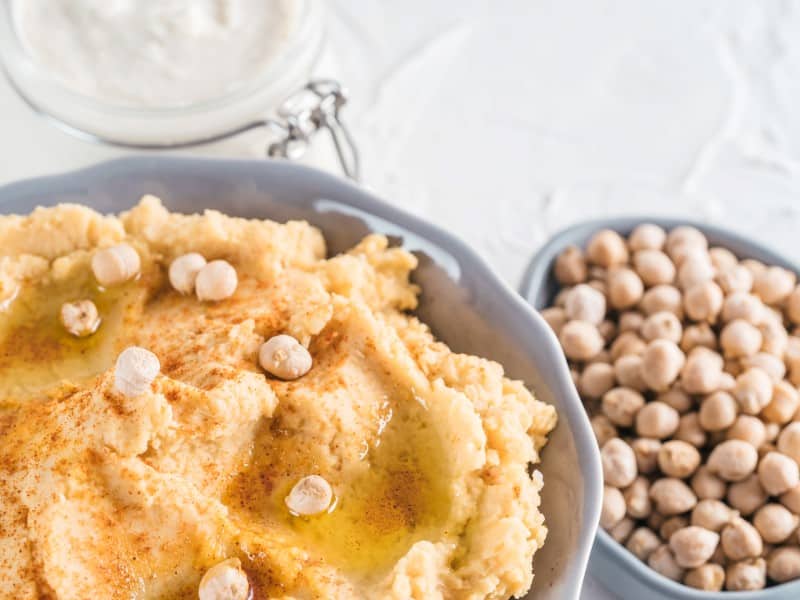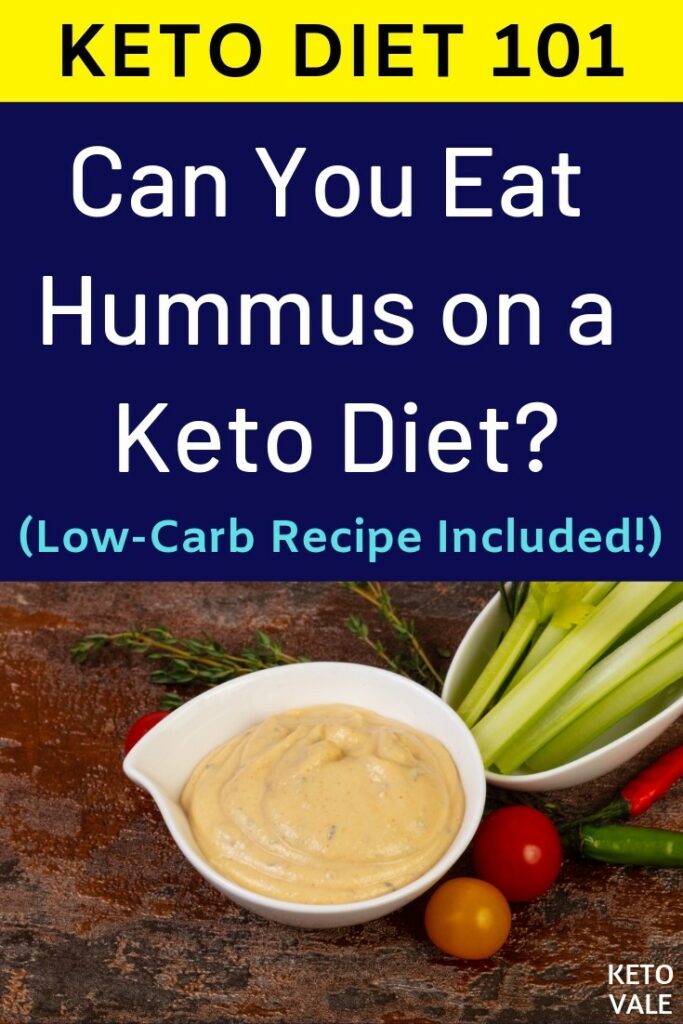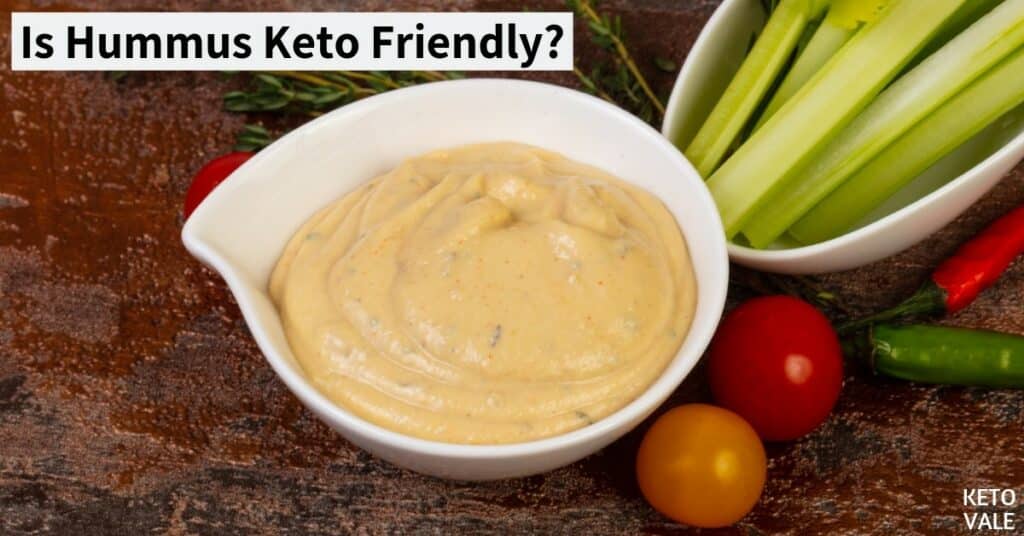Hummus has long been promoted among health professionals for its many health benefits. It’s full of fiber, plant-based protein, vitamins, minerals, and antioxidant plant chemicals.
You can find it in just about any grocery store, but if you want the good stuff, then you’ll need to visit your local Middle Eastern restaurant where they make it fresh.
Hummus is commonly used on pita sandwiches as a delicious spread or to dip bread and vegetables in. You can find it on the appetizer section in most Middle Eastern restaurants, but it also accompanies many main dishes, too.
The main ingredient in hummus is chickpeas, which is a legume. Legumes are off-limits on the keto diet because they are high in carbs, but some keto dieters wonder if they can eat it on this diet in moderation.
Find out here what hummus is and whether or not you can eat this food on the ketogenic diet.
What Is Hummus?
Hummus is a delicious Middle Eastern-inspired dip or spread made by blending together cooked chickpeas, tahini (sesame paste), chopped garlic, fresh lemon, olive oil, and a blend of delicious spices in a high-speed blender.
Chickpeas are otherwise known as garbanzo beans. They are an old world pulse or an edible seed that belongs to the legume family.

They have been used in cultures for many centuries due to their nutty flavor and versatile applications. They are thought to have originated in ancient Egypt.
There are two primary types of chickpeas. The first is a light seed called Kabouli and the other is a small, dark seed called Desi (1).
Pulses are higher in protein than other plant foods. They contain approximately 17% to 30% protein by dry weight. The main forms of protein found in chickpeas are albumins, globulins, glutelins and prolamines (2).
The texture of hummus is smooth and creamy, and it makes for a great spread on your favorite sandwiches. It’s also a great dipping sauce for baked pita bread and sliced vegetables, such as carrots, cucumbers, and celery.
Research shows that people who eat chickpeas or hummus have higher levels of fiber, polyunsaturated fatty acids, vitamins A, C and E, magnesium, folate, iron, and potassium when compared to people who don’t eat chickpeas for hummus (1).
Additional research shows that hummus and chickpeas may play a positive role in weight management as well as insulin regulation and glucose maintenance. It may also positively affect several markers that influence cardiovascular disease (1).
Chickpeas and hummus are a good source of dietary compounds, including tannins, sterols, phytic acid, carotenoids and other polyphenols that include isoflavonoids. They are also a good source of vitamins and minerals, especially calcium, potassium, folate, and magnesium.
Chickpea consumption has skyrocketed over the past decade in the western world. In 2013 alone, the hummus Market grew to over $530 in the United States. This was an increase of over 25% since 2010. In 2014, over 14.2 metric tons of chickpeas were harvested primarily for the use of hummus.
Traditional hummus is made by cooking and mashing chickpeas and blending them with tahini, olive oil, spices, and lemon juice. You can find a variety of other types of hummus in the supermarket, such as bean-based dips.
However, these dips do not follow the typical hummus recipe. Examples of these “knock-off hummus brands” include black bean dip or hummus made with white beans.
Four tablespoons of hummus provide you with 25 grams of fiber, which is the daily recommended value. The same amount of hummus also contains 14 grams of plant-based protein.
Here is the nutritional breakdown of a 100-gram serving of store-bought hummus (3):
- 166 calories
- 9.6 grams of fat
- 14.3 grams of carbohydrates (8.3 grams of net carbs)
- 6 grams of fiber
- 7.9 grams of protein
Vitamins:
- Vitamin A: 30 IU (1% RDV*)
- Thamin: 0.2 mg (12% RDV)
- Riboflavin: 0.1 mg (4% RDV)
- Niacin: 0.6 mg (3% RDV)
- Vitamin B6: 0.2 mg (10% RDV)
- Folate: 83 mcg (21% RDV)
- Pantothenic Acid: 0.1 mg (1% RDV)
Minerals:
- Calcium: 38 mg (4% RDV)
- Iron: 2.4 ml (14% RDV)
- Magnesium: 71 mg (18% RDV)
- Phosphorus: 176 mg (18% RDV)
- Potassium: 228 mg (7% RDV)
- Sodium: 379 mg (16% RDV)
- Zinc: 1.8 mg (12% RDV)
- Copper: 0.5 mg (26% RDV)
- Manganese: 0.8 mg (39% RDV)
- Selenium: 2.6 mcg (4% RDV)
*RDV = recommended daily value

How is Traditional Hummus Made?
Traditional hummus is made by blending together cooked or mashed chickpeas, olive oil, freshly squeezed lemon juice, fresh, whole garlic cloves, and spices.
The chickpeas will need to be soaked overnight in water, drained the next day, rinsed off with fresh water, and then cooked before they can be used in a hummus recipe.
After they are soaked overnight, the easiest way to cook your chickpeas is to boil them in a pot of water until they are soft.
Soaking your chickpeas and other legumes overnight in water helps deactivate certain proteins that are hard to digest. People who eat baked chickpeas without soaking them first may have problems digesting these proteins.
This is one of the reasons why many people with digestive disorders cut out legumes, such as chickpeas, from their diet. However, most of the digestive distress caused by chickpeas can be eliminated or greatly reduced by soaking them overnight in water.
For convenience, many people used canned chickpeas, which often come in cooked form so that you don’t have to soak or boil your chickpeas. However, the best tasting hummus is always made from scratch using fresh ingredients.
Here is a recipe for traditional hummus (4):
- One can or 200 grams/7 ounces of canned chickpeas
- 2 whole garlic cloves
- 2 tablespoons of freshly squeezed lemon juice
- 1 tablespoon tahini
- 4 tablespoons water
- 2 tablespoons olive oil
- A pinch of sea salt
- 1 teaspoon cumin
- 1 teaspoon paprika
The first thing you’ll want to do to make hummus is to prepare your chickpeas. If you’re using dry chickpeas, empty them into a bowl and soak them in water overnight or for eight hours.
Once they are soaked, rinse them off. Fill a large pot with fresh water and boil the chickpeas for several hours until they are soft. Take them off the burner, let them cool, and then strain them. If you’re using canned chickpeas, you won’t need to do this step.
Drain and rinse your chickpeas if you’re using canned. Some people use the water that comes in the canned chickpeas in their hummus recipe to enhance the flavor. Place all ingredients in a high speed blender and pulse until you reach your desired consistency.
For a thinner and smoother hummus, try adding more olive oil or water. If you like your hummus a bit sweeter, then try adding more lemon. If you’re using canned chickpeas, you may not want to use sea salt as canned chickpeas usually already have salt in them.
You can get creative and add other vegetables to your hummus, such as roasted red pepper. Some people top their hummus with additional oil, chopped garlic, or sesame seeds.
You can add your freshly made hummus to your favorite sandwich pitas or dip your favorite vegetables in it. Some people use it on top of salads in place of salad dressing.
Is Hummus Keto-Friendly?
As delicious as hummus it, it is not a keto-friendly food. This is because chickpeas are a legume and they are high in starch and carbs.
For comparison, peanuts and green peas also fall into the category of a legume, which makes them off limits on the keto diet.
You could make the argument that because hummus contains 8.3 grams of net carbs per 100-gram serving, you could eat it in moderation. However, overeating hummus is easy to do.
Since you need to limit your carb intake to 20-25 grams per day, it’s best to get those carbs by eating low-carb vegetables, such as kale, spinach, broccoli, and cabbage.
Low-carb veggies are highly nutritious. You’ll find equal amounts of vitamins, minerals, antioxidants, and fiber in them as you would in hummus, but without the high carbs. Their pair well with meat-based dishes and fully support your keto needs.
In addition to being high in carbs, hummus and other legumes tend to be hard to digest. Many people go on the keto diet to avoid foods that cause them digestive upset, and legumes are one of them.
As we mentioned above, soaking your legumes in water overnight can deactivate hard-to-digest proteins, but cutting them out of your diet is the best way to see results.
Low Carb Hummus Substitute Recipe
Because the primary ingredient in hummus is chickpeas, and chickpeas are not allowed on the ketogenic diet menu, it would be hard to create a keto recipe that mimics traditional hummus exactly.
What can you substitute for chick peas in a keto hummus? Many people use cauliflower in place of chickpeas to make their own keto-friendly hummus at home.
Cauliflower is a good substitute because it has a white color and blends in with the tahini paste to take on the look of traditional hummus.
Cauliflower also has a mild flavor so it takes on the taste of the tahini. Many people report that they don’t miss traditional hummus very much when they use cauliflower in place of chickpeas.
You can also use avocado in place of chickpeas to create a keto-friendly hummus. Avocado is smooth, rich and creamy, and it makes a great substitute as a keto-friendly dip.
But keep in mind that using avocado will turn your hummus green and this is not the traditional color of hummus. To avoid the green color, you could try adding some sour cream to the mix. But this concoction is far from the traditional hummus recipe.
Try this low-carb non-chickpea hummus recipe the next time you’re in need of a healthy dip but don’t want all the carbs.
How to make keto hummus:
- 3 cups of cauliflower, cooked (boiled and drained) so that they are soft
- 2 whole garlic cloves
- 2-3 tablespoons of freshly squeezed lemon juice
- 2 tablespoons tahini
- 2 tablespoons water
- 3-4 tablespoons olive oil
- A pinch of sea salt
- 1 teaspoon cumin
- 1 teaspoon paprika
To make this hummus recipe, boil your cauliflower so that it’s soft and ready to blend. Drain it and pat it dry with a paper towel to soak up the access water.
To make up for the bland taste of the cauliflower, we suggest adding less water and more olive oil, lemon juice and tahini to your recipe. This should help balance out the flavor and make up for the lack of chickpeas. Adding more tahini should also balance out the texture.
Add all ingredients into a blender and blend on high speed. Add the water, lemon juice, and olive oil in slowly until you reach your desired texture. You can also try experimenting with different spices in your hummus, such as oregano, basil, or thyme.
Conclusion
Hummus is a Middle Eastern inspired dip that is made by blending together cooked chickpeas, olive oil, tahini or sesame paste, olive oil, fresh lemon, and spices.
Although it has been praised for being extremely healthy among the plant-based community due to its high fiber, protein, and vitamin and mineral content, hummus is not a keto-friendly food. This is because chickpeas, the main ingredient in hummus, are high in carbs.
Legumes such as chickpeas also contain special proteins that are hard to digest. Soaking your legumes in water overnight can deactivate these proteins, but keeping them out of your diet entirely is the best way to get digestive relief.
You can make your own keto-friendly hummus recipes using cauliflower or avocado, but the taste will not be exactly the same. You can also omit the chickpeas entirely and use tahini as your main ingredient. Again, the texture might not be the same, but you will be saving on carbs.
Enjoy this post? Share to save for later!

Photos credit: AndreySt&Fascinadora/Depositphotos.com & pixabay.com







